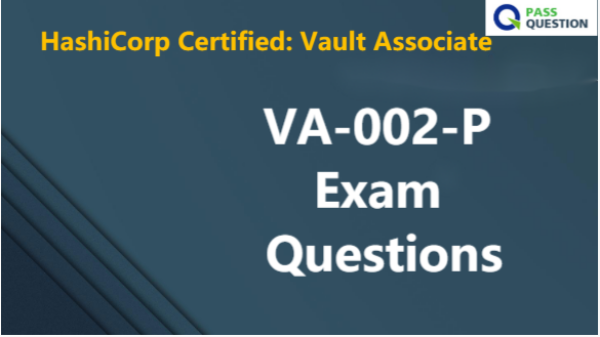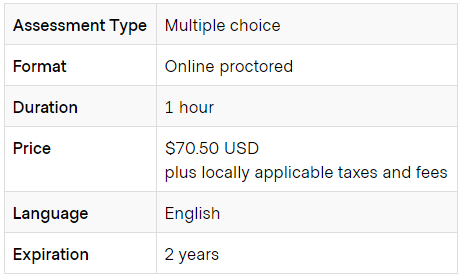VA-002-P Exam Questions To Pass HashiCorp Certified: Vault Associate
Want to pass HashiCorp Certified: Vault Associate exam? PassQuestion VA-002-P Exam Questions offer a lot of information for your exam guide, including the questions and answers. The accuracy rate of VA-002-P Exam Questions provided by PassQuestion is very high and they can 100% guarantee you pass the exam successfully for one time. Besides, we will provide you a free one-year update service. With the learning information and guidance of PassQuestion, you can through HashiCorp Certified: Vault Associate VA-002-P exam in the first time.

HashiCorp Certified: Vault Associate
The Vault Associate certification is for Cloud Engineers specializing in security, development, or operations who know the basic concepts, skills, and use cases associated with open source HashiCorp Vault. Candidates will be best prepared for this exam if they have professional experience using Vault in production, but performing the exam objectives in a personal demo environment may also be sufficient. This person understands what enterprise features exist and what can and cannot be done using the open source offering.
Exam Details

Exam Objectives
1 Compare authentication methods
- 1a Describe authentication methods
- 1b Choose an authentication method based on use case
- 1c Differentiate human vs. system auth methods
2 Create Vault policies
- 2a Illustrate the value of Vault policy
- 2b Describe Vault policy syntax: path
- 2c Describe Vault policy syntax: capabilities
- 2d Craft a Vault policy based on requirements
3 Assess Vault tokens
- 3a Describe Vault token
- 3b Differentiate between service and batch tokens. Choose one based on use-case
- 3c Describe root token uses and lifecycle
- 3d Define token accessors
- 3e Explain time-to-live
- 3f Explain orphaned tokens
- 3g Create tokens based on need
4 Manage Vault leases
- 4a Explain the purpose of a lease ID
- 4b Renew leases
- 4c Revoke leases
5 Compare and configure Vault secrets engines
- 5a Choose a secret method based on use case
- 5b Contrast dynamic secrets vs. static secrets and their use cases
- 5c Define transit engine
- 5d Define secrets engines
6 Utilize Vault CLI
- 6a Authenticate to Vault
- 6b Configure authentication methods
- 6c Configure Vault policies
- 6d Access Vault secrets
- 6e Enable Secret engines
- 6f Configure environment variables
7 Utilize Vault UI
- 7a Authenticate to Vault
- 7b Configure authentication methods
- 7c Configure Vault policies
- 7d Access Vault secrets
- 7e Enable Secret engines
8 Be aware of the Vault API
- 8a Authenticate to Vault via Curl
- 8b Access Vault secrets via Curl
9 Explain Vault architecture
- 9a Describe the encryption of data stored by Vault
- 9b Describe cluster strategy
- 9c Describe storage backends
- 9d Describe the Vault agent
- 9e Describe secrets caching
- 9f Be aware of identities and groups
- 9g Describe Shamir secret sharing and unsealing
- 9h Be aware of replication
- 9i Describe seal/unseal
- 9j Explain response wrapping
- 9k Explain the value of short-lived, dynamically generated secrets
10 Explain encryption as a service
- 10a Configure transit secret engine
- 10b Encrypt and decrypt secrets
- 10c Rotate the encryption key
View Online HashiCorp Certified: Vault Associate VA-002-P Free Questions
1. You can migrate the Terraform backend but only if there are no resources currently being managed.
A. False
B. True
Answer: A
2.When multiple engineers start deploying infrastructure using the same state file, what is a feature of remote state storage that is critical to ensure the state does not become corrupt?
A. state locking
B. object storage
C. encryption
D. workspaces
Answer: A
3.Vault secrets engines are used to do what with data? (select three)
A. copy
B. generate
C. store
D. transmit
E. encrypt
Answer: B,C,E
4.What is the purpose of using the local-exec provisioner? (select two)
A. ensures that the resource is only executed in the local infrastructure where Terraform is deployed
B. to execute one or more commands on the machine running Terraform
C. to invoke a local executable
D. executes a command on the resource to invoke an update to the Terraform state
Answer: B,C
5.Which command is used to initialize Vault after first starting the Vault service?
A. vault create key
B. vault operator init
C. vault operator initialize keys
D. vault start
E. vault operator unseal
Answer: B
- TOP 50 Exam Questions
-
Exam
All copyrights reserved 2025 PassQuestion NETWORK CO.,LIMITED. All Rights Reserved.

